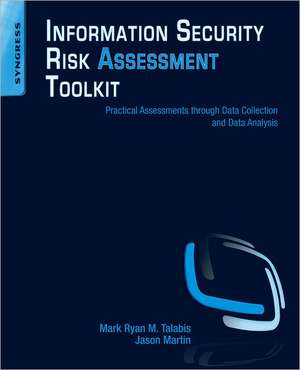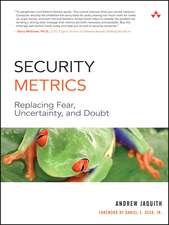Information Security Risk Assessment Toolkit: Practical Assessments through Data Collection and Data Analysis
Autor Mark Talabis, Jason Martinen Limba Engleză Paperback – 14 dec 2012
- Based on authors’ experiences of real-world assessments, reports, and presentations
- Focuses on implementing a process, rather than theory, that allows you to derive a quick and valuable assessment
- Includes a companion web site with spreadsheets you can utilize to create and maintain the risk assessment
Preț: 223.59 lei
Preț vechi: 287.16 lei
-22% Nou
Puncte Express: 335
Preț estimativ în valută:
42.78€ • 44.67$ • 35.41£
42.78€ • 44.67$ • 35.41£
Carte tipărită la comandă
Livrare economică 29 martie-12 aprilie
Livrare express 01-07 martie pentru 42.03 lei
Preluare comenzi: 021 569.72.76
Specificații
ISBN-13: 9781597497350
ISBN-10: 1597497355
Pagini: 278
Ilustrații: 45 illustrations
Dimensiuni: 191 x 235 x 16 mm
Greutate: 0.58 kg
Editura: ELSEVIER SCIENCE
ISBN-10: 1597497355
Pagini: 278
Ilustrații: 45 illustrations
Dimensiuni: 191 x 235 x 16 mm
Greutate: 0.58 kg
Editura: ELSEVIER SCIENCE
Public țintă
Information Security Officers, IT Auditors, IT Professionals, Chief Information Officers, Privacy Officers, Risk Officers, IT Enterprise ArchitectsCuprins
Chapter 1: Information Security Risk Assessments
Chapter 2: A Practical Approach
Chapter 3: Data Collection
Chapter 4: Data Analysis
Chapter 5: Risk Assessment
Chapter 6: Risk Prioritization and Treatment
Chapter 7: Reporting
Chapter 8: Maintenance and Wrap Up
Chapter 2: A Practical Approach
Chapter 3: Data Collection
Chapter 4: Data Analysis
Chapter 5: Risk Assessment
Chapter 6: Risk Prioritization and Treatment
Chapter 7: Reporting
Chapter 8: Maintenance and Wrap Up








